Closed to the public, but Sarkozy gains access to threatened cave art

Your support helps us to tell the story
From reproductive rights to climate change to Big Tech, The Independent is on the ground when the story is developing. Whether it's investigating the financials of Elon Musk's pro-Trump PAC or producing our latest documentary, 'The A Word', which shines a light on the American women fighting for reproductive rights, we know how important it is to parse out the facts from the messaging.
At such a critical moment in US history, we need reporters on the ground. Your donation allows us to keep sending journalists to speak to both sides of the story.
The Independent is trusted by Americans across the entire political spectrum. And unlike many other quality news outlets, we choose not to lock Americans out of our reporting and analysis with paywalls. We believe quality journalism should be available to everyone, paid for by those who can afford it.
Your support makes all the difference.President Nicolas Sarkozy and his wife, Carla Bruni, treated themselves to a visit to the most secretive – and most threatened – art gallery in the world yesterday. Seventy years to the day after the discovery of the Lascaux caves in the Dordogne, an eight strong presidential party entered the fragile underground chambers, which contain 900 of the most perfect surviving examples of prehistoric art.
The visit, like most things about Lascaux, was controversial. The caves, banned to the public since 1963, have been menaced in recent years by a series of unexplained, and only partially controlled, fungal invasions. Any human presence in the caves is regarded as potentially destructive. Normally, they are entered only once a week by one security guard for a few minutes at a time.
The eight people in the presidential party, including the Culture Minister, Frédéric Mitterrand, spent 30 minutes in the 200-metre-long complex of caves. They were under strict instructions to keep moving and to avoid staring at individual paintings. To "compensate" for the heat and humidity of their presence, normal security checks were cancelled for two weeks.
Laurence Léauté-Beasley, the president of an independent international committee which campaigns for the protection of the caves, said: "One cannot help wondering whether this is not so much a celebration as the eve of the funeral service for Lascaux."
Mr Sarkozy appeared to be deeply moved by his visit. "It is as if you have entered a cathedral," he said. "To think that even 18,000 years ago, human beings knew how to express their emotions so beautifully is something that touched us deeply. Carla and I know how extremely privileged we are to have entered the Lascaux caves." The visit marked the 70th anniversary of the accidental discovery of the site by four 13-year-old boys and a dog in September 1940. The paintings at Lascaux, now perhaps the best known of all cave paintings, exceeded in quality and quantity anything that had previously been found in Europe.
The 900 images of aurochs (extinct ancestors of domestic cattle), wild horses, bison and ibexes – some at rest, some running or jumping – were painted between 15,000 and 18,000 years ago. Hunter-gatherers crushed minerals to create paints in red, ochre, brown and black. Whether the site was of religious or social importance is unknown.
Following a visit to the caves soon after their discovery, Pablo Picasso, known for the simplicity and purity of his brush-strokes, declared: "We have invented nothing."
Lascaux was closed to the public in 1963 to protect the caves from just the kind of fungal infections which have appeared in the last nine years. In 1983, a complete life-sized facsimile of the caves and paintings – Lascaux Two – was opened nearby. Some scientists fear that the success of this building – which attracts 250,000 visitors a year – may have disturbed the micro-climate in the original caves
In February 2009, Unesco threatened to humiliate France by placing Lascaux on its list of endangered sites of universal importance. This followed a series of botched, and then partially successful, attempts to fight off first white, and then ugly grey and black fungi, which began to creep over the paintings in 2001.
Ms Léauté-Beasley's independent committee of concerned scientists has complained that the French government has imposed an omerta, or veil of secrecy, on the site. A new curator appointed last year, Muriel Mauriac, says that the stricter controls on climate within the caves have begun to remove the fungi. "But we have still a long way to go before we understand the origins of this crisis," she said.
Join our commenting forum
Join thought-provoking conversations, follow other Independent readers and see their replies
Comments